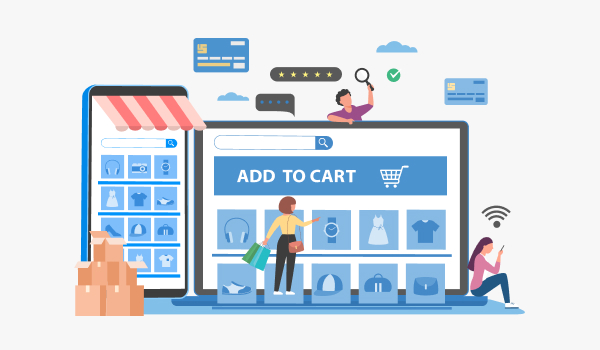
The implementation of multiple online stores can help Uniform sellers enhance their interaction with their current customers, as well as allows them to penetrate into markets that had previously been inaccessible. Few ways that businesses leveraging multi-store eCommerce sites can accomplish these goals include:
 Going D2C
Going D2C
A uniform manufacturer pivoting away from partnering with retailers, and towards selling directly to the end consumer, has a stark need for a multi-store eCommerce solution. For each industry-vertical or region that they operate in, there is a need to create unique & customized buying experiences to sell uniforms, collect data, host flash-sales, and everything else required to successfully go D2C
 Brand Separation
Brand SeparationA major reason for a multistore eCommerce approach is so that large uniform selling businesses operating under multiple brand names can create separate & unique stores for each individual brand—while using a single platform.
 Expanding into New Markets
Expanding into New MarketsExpansion does not just stop at new products but also transcends new rules, new customizations, and new web stores. Multi-store eCommerce will ensure that the framework is correct and consistent.
 Different customer types
Different customer typesAs a uniform seller who deals with both B2B and B2C clients, you will need to develop different online stores for each of those audiences. Pricing, availability, and payment terms may differ widely between them, so each store would need to handle those differences.
The creation, development, and management of multiple online stores can be difficult. Businesses must deal with different brands, different customers, different inventories, and even different languages as they develop their online eCommerce sites. Other challenges can include:
 Data management
Data managementWith multiple inventories, customers, employee databases, and multiple ordering systems to manage, the tasks involved in keeping the data for multiple online stores up to date and consistent is a significant challenge.
When a uniform seller is running more than one online store with the same or similar brands, brand managers have to ensure that the brand’s messages stay consistent across every store and across multiple portals, such as laptops, tablets, and smartphones.
 Integrating various systems
Integrating various systemsFrom inventory to payment processing, the processes involved in managing an online store must also include integrating various systems to ensure that they work together smoothly. When a seller operates multiple stores, the challenges of integrating these systems can also increase.
 Lack of resources
Lack of resourcesThe cure to the problems listed above can also create a problem of its own, as uniform sellers try to stretch their resources to manage multiple stores. The effort needed to keep each store up to date can eat up valuable time, money, and man-hours.
One should treat the development of each online store as if it were the only one they had in operation. At the same time, they must also view each online store as a tool in their overall business strategy. Some of the steps that uniform sellers can take to attack both of these issues include:
 Identify niche or regional markets for each store
Identify niche or regional markets for each storeVendors who develop stores that seek to fill the needs of niche markets can often see an increase in brand loyalty, which means higher rates of returning customers. Niche marketing can refer to targeting a specific market that either lives in a specific area, earns a specific income, or has certain eclectic tastes.
.png?width=74&name=group%20(1).png) Use a headless content management system
Use a headless content management system A headless content management system (CMS) ensures that your content will be consistent across multiple platforms and devices, including devices like Amazon Echo and Google Home.
Since headless commerce is starting to gain traction, based on the forecasted voice commerce revenues of $40 billion in the US alone expected in 2022, it is now crucial for brands to invest in a headless CMS platform and integrate eCommerce capabilities into it.
UniformMarket provides a SaaS-based decoupled headless CMS that comes with a multitude of eCommerce features built-in. The platform lets uniform sellers online create personalized online shopping experiences for customers in each target market. And UniformMarket’s multi-tenant features allow you to manage multiple stores, while the WYSIWYG content management system allows marketers to create consistent messages across all platforms.
 Develop a coherent Content & SEO strategy
Develop a coherent Content & SEO strategyManaging search engine optimization (SEO) for multiple online stores is a huge challenge. You have to think about how you can optimize titles, tags, header tags, meta descriptions and so on for every online store. When you got a handful of stores, let’s say two or three, it is just about manageable, but when you have hundreds, even thousands, of sites, it is an extremely time-intensive exercise to optimize each site.
 Develop a master inventory database
Develop a master inventory databaseA major challenge surrounding the implementation of multiple eCommerce stores involves maintaining inventory databases. When you’re having to deal with separate inventories, stock level discrepancies are bound to happen. For instance, if you have two sites selling the same product, there is going to be manual intervention to reconcile each product, inventory, and SKUs, and if they are not reconciled automatically at regular intervals, you risk having inaccurate stock levels.
A single master copy of the inventory database can save time and effort, while also avoiding problems with customers expecting an item that is no longer in stock.
UniformMarket gives you the ability to control and manage multiple stores from a single dashboard. You can create multiple stores to cater to any audience of their choosing. UniformMarket also allows you to track sales metrics from each store to determine which ones are meeting expectations.
"A multi-site eCommerce platform is a key to international growth"
Whether you’re serving different regions or managing several brands, entering international markets requires a multi-store eCommerce platform.
Multi-store management helps brands stay relevant in local markets, separate their brands, and simultaneously manage their entire eCommerce ecosystem from the same dashboard.
International eCommerce brands are leveraging UniformMarket as their multi-store eCommerce solution, taking advantage of our SaaS infrastructure, headless commerce capabilities, industry-leading hands-on customer support, and 80+ web content management and eCommerce features.